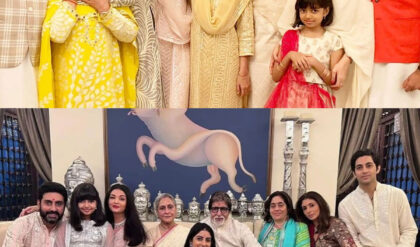Why Anant Ambani’s $600 million wedding is just business as usual
Anant, the youngest of the 67-year-old’s three children, kicked off his marriage celebration in March
)
By Andy Mukherjee
Mukesh Ambani once revealed that he watches as many as three Bollywood movies a week in his home theater. “You need some amount of escapism in life,” the Indian tycoon told the New York Times in 2008. “Those two or three hours give you relief.”
Sixteen years later, the oligarch is more than just a consumer of make-believe. He is now a purveyor of mass entertainment, a media mogul preparing for the stock-market listing of a digital empire worth as much as $112 billion, according to Jefferies. And what better way to start the countdown than by inviting the world’s rich, glamorous and powerful to a five-month-long wedding extravaganza?
Anant, the youngest of the 67-year-old’s three children, kicked off his marriage celebration in March. Rihanna performed at a prenuptial bash at a private wildlife sanctuary that occupies 3,000 acres inside Ambani’s refinery complex on India’s western coast. The festivities ended with back-to-back galas over the weekend in Mumbai. Most of Bollywood turned up to shake a leg, as did the Kardashians. This was two weeks after a pre-wedding function headlined by Justin Bieber. In between, the party had continued on a European cruise, joined in Italy by the Backstreet Boys — and in Cannes by Katy Perry.
From Meta Platforms Inc.’s Mark Zuckerberg, a key investor in Ambani’s digital ambitions, to Jay Y. Lee, the Samsung Electronics Co. boss who supplies him 5G equipment, the invitees who sampled the merriment at one event or another got a reminder of the family’s unrivaled status in India’s corporate landscape. Media estimates put the total cost of the festivities at $600 million.
Anant, the youngest of the 67-year-old’s three children, kicked off his marriage celebration in March. Rihanna performed at a prenuptial bash at a private wildlife sanctuary that occupies 3,000 acres inside Ambani’s refinery complex on India’s western coast. The festivities ended with back-to-back galas over the weekend in Mumbai. Most of Bollywood turned up to shake a leg, as did the Kardashians. This was two weeks after a pre-wedding function headlined by Justin Bieber. In between, the party had continued on a European cruise, joined in Italy by the Backstreet Boys — and in Cannes by Katy Perry.
From Meta Platforms Inc.’s Mark Zuckerberg, a key investor in Ambani’s digital ambitions, to Jay Y. Lee, the Samsung Electronics Co. boss who supplies him 5G equipment, the invitees who sampled the merriment at one event or another got a reminder of the family’s unrivaled status in India’s corporate landscape. Media estimates put the total cost of the festivities at $600 million.
Glimpses of opulence were made available to the wider public on Ambani-owned news media. I don’t know what gifts the guests brought with them, but the bridegroom’s close friends went home with Audemars Piguet watches in 18-karat pink gold. Meanwhile, many of the 480 million-plus customers of Ambani’s Jio wireless service are paying 21 per cent more for data starting this month. While that became a topic for online memes, the more serious question is: Why put the family fortune on display now, when Brazil has moved a proposal to tax the world’s super-rich 2 per cent of their wealth annually?
Indian steel magnate Lakshmi Mittal rented the Tuileries garden in Paris — and Louis XIV’s chateau in Versailles — for his daughter’s wedding in 2004, two years before he won the bidding battle for Luxembourg’s Arcelor SA. The six-day bash reportedly cost $60 million. That was a different milieu. Not only has the Ambani family set a new record, it did most of the splurging at home. And that, too, when domestic politics has taken a turbulent turn, and acute inequality of India’s “Billionaire Raj” is drawing criticism.
Prime Minister Narendra Modi’s grip on power has weakened since his party lost its parliamentary majority last month. During a bruising poll campaign, Rahul Gandhi, the main opposition leader, relentlessly attacked Modi for working in the interests of only two businessmen: Ambani and Gautam Adani. Economists Josh Felman and Arvind Subramanian call it the “2A variant of India’s stigmatised capitalism.” Favoring a tiny coterie is one reason, they say, why foreign direct investment into India is sliding and private capital expenditure is stagnant. Nobody wants to go up against the national champions.
It will be interesting to see if an altered political reality forces Ambani’s consumer empire to face more competition. Tellingly, Modi showed up to greet the newly wed couple, as did prominent opposition leaders. Gandhi stayed away.
But Ambani may be taking a calculated risk on his ability to manage politics. The priority is to sustain the 43 per cent rally in his flagship Reliance Industries Ltd.’s shares in the past eight months. That calls for some boldness and excitement, to gain an advantage against his main rival. Adani, 62, has put last year’s debilitating short-seller attack behind him. He’s unlikely to remain confined to infrastructure like ports, airports, data centers and building materials. Adani wants one in three Indians to be on his fledgling super-app by the end of the decade. How will he ever acquire them without competing with Ambani in a large consumer-facing industry like telecom or payments?
It is this moat that Ambani must protect. After agreeing to merge his media operations with Walt Disney Co.’s TV franchise in India, he has a lock on Bollywood and cricket, the two offerings that unfailingly grab eyeballs in the world’s most-populous nation. A new consumer finance and payments unit — spun off from the mothership last year — is hiring key executives. A public float for the digital platform perhaps as early as next year, followed by one for India’s No. 1 retail chain, will leave Ambani in an unassailable position. A secure empire can be safely entrusted to the next generation.
Now is not the time to lie low, but to exude confidence. Morgan Stanley’s Michael Grimes, who helped Reliance raise more than $20 billion from Zuckerberg and other investors during the pandemic, was on the guest list. He should be a happy tech banker. His firm’s analysts expect the conglomerate to add $100 billion to its $260 billion market value.
And why not? More than one billion Indians are looking for an escape from staggering youth unemployment, lackluster wages, and stubbornly high inflation. As long as they pay for the data, Ambani will deliver all the distraction they need on their smartphones and broadband TV — and even throw in snippets of a $600 million wedding into the package.





